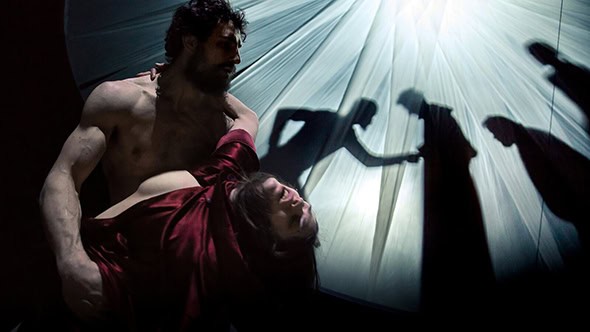Ultima Vez, Mockumentary of a Contemporary Saviour at Queen Elizabeth Hall
Posted: March 10th, 2019 | Author: Nicholas Minns | Filed under: Performance | Tags: Anabel Lopez, Bart Meuleman, Charo Calvo, Flavio d’Andrea, Jason Quarles, Maria Kolegova, Meryem Bayram, Saïd Gharbi, Ultima Vez, Wim Vandekeybus, Wouter Bruneel, Yun Liu | Comments Off on Ultima Vez, Mockumentary of a Contemporary Saviour at Queen Elizabeth HallUltima Vez, Mockumentary of a Contemporary Saviour, Queen Elizabeth Hall, March 1

Since he started his Brussels-based company, Ultima Vez, in 1986 the prolific choreographer, filmmaker and director Wim Vandekeybus has sought innovative approaches to dance and theatre beginning with his first work, What the Body Does Not Remember. One might say that he has established choreography as a form of discourse on a wide variety of subjects that preoccupy him — myth, belief, faith, subconscious desires, dreams, life and death. (In May the Brighton Festival will be presenting his latest work, TrapTown, that questions conflict and freedom). As in modernist architecture’s mantra of ‘form follows function’, each production takes on a form that grows out of the subject but Vandekeybus nonetheless remains true to a physical movement vocabulary that embodies tension and conflict, risk and impulse, intuition and instinct, passion and endurance. In his recent work, Mockumentary of a Contemporary Saviour, presented at Queen Elizabeth Hall, he draws on the different cultural traditions of his seven performers — Anabel Lopez, Maria Kolegova, Jason Quarles, Wouter Bruneel, Yun Liu, Flavio d’Andrea and Saïd Gharbi — to create an ironic, perhaps even caustic documentary of salvation.
In an era of unprecedented migration with its underlying plurality of faiths, Vandekeybus broadens the scope of Mockumentary of a Contemporary Saviour to include any religious remit that promises the kind of salvation where utopia and dystopia are interwoven. The set with its circular centre conceived by Vandekeybus and Meryem Bayram describes a nondescript place reminiscent of Andrei Tarkovsky’s Stalker in which three men and two women have been saved as the ‘chosen ones’ and as in Stalker, there is no way out. It is into the midst of this circle, dominated by a transparent halo-like ceiling, that Bruneel, a big-bellied, lusty western psychologist in orange safety overalls, suddenly appears: his ‘corpse’ drops through the halo and lands with a thud on the ground. His body is ‘still warm’ and the community, already conversant with the notion of a saviour and convinced he is a sign of divine intervention, revives him. Ironically Bruneel’s unexpected arrival sets off a cacophonous dispute about belief, death and preparations for the next life. Even if the location of the space is indeterminate, we learn from Bruneel that the world as we know it is in a state of disintegration, suggesting this is a purgatorial staging post; hence the importance of signs that might lead to a possible way out.
The internal conflicts, cultural differences, and encounters between the characters are played out as physical and verbal commotions against a rumbling score by Charo Calvo in which Vandekeybus’s characteristic muscular idiom articulates their grief, desires, hopes and sense of resignation. Although a spoken text devised by Bart Meuleman and Ultima Vez predominates as the main expressive form in Mockumentary of a Contemporary Saviour, it is the heightened physicality of both voice and body that unleashes the full dynamics of the contradictory forces within the community. Lurking close to the surface of the bonds that tie the seven people in their precarious existence is a violence that threatens to destroy them.
Vandekeybus’ timely reflection on the power of belief is based not so much on the presence but rather the absence of ‘the child’. We learn that Lopez is a mother whose son has died; early in the piece she is addressed as Martha. Gharbi, a blind seer who represents spiritual clarity, suggests she has to let go of her dead child if she wants him to forgive her. The deliberate conflation of her personal salvation with the biblical Martha’s acceptance of Christ’s resurrection is further corroborated when her son, once freed from her motherly love, is lowered down into the space like an effigy and immediately recognized by the community as proof of the saviour’s existence. Armed with this conviction they clamber enthusiastically over the audience to proselytize in their respective languages till they make their exit through the auditorium doors, leaving the blind Gharbi on stage communicating with the sound of his clicking fingers alone. Vandekeybus thus ends his provocative interrogation of faith with Gharbi’s quiet, meditative gesture that in its simplicity elicits a response from the audience without any misplaced belief or truth assigned to it.
Mockumentary of A Contemporary Saviour is a reminder from continental Europe of the robust role choreography can play in philosophical debate. In this country we are not familiar with it being used in this way and it pushes hard, if uncomfortably, against a prevalence of aesthetic movement that risks limiting the art form’s full development.